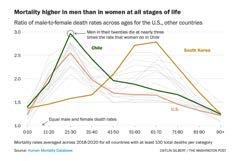



































































A silent crisis in men’s health is shortening the life spans of fathers, husbands, brothers and sons. For years, the conventional wisdom has been that a lack of sex-specific health research mainly hurts women and gender minorities. While those concerns are real, a closer look at longevity data tells a more complicated story. Across the life span — from infancy to the teen years, midlife and old age — the risk of death at every age is higher for boys and men than for girls and women.
The result is a growing longevity gap between men and women. In the United States, life expectancy in 2021 was 79.1 years for women and 73.2 years for men. That 5.9-year difference is the largest gap in a quarter-century. (The data aren’t parsed to include differences among nonbinary and trans people.) “Men are advantaged in every aspect of our society, yet we have worse health outcomes for most of the things that will kill you,” said Derek Griffith, director of Georgetown University’s Center for Men’s Health Equity in the Racial Justice Institute.“We tend not to prioritize men’s health, but it needs unique attention, and it has implications for the rest of the family. It means other members of the family, including women and children, also suffer.” The longevity gap between men and women is a global phenomenon, although sex differences and data on the ages of greatest risk vary around the world and are influenced by cultural norms, record keeping and geopolitical factors such as war, climate change and poverty. But data looking at health risks for boys and men in the United States paint a stark picture.
• Men are at a greater risk of dying from covid-19 than women, a gap that cannot be explained by rates of infection or preexisting conditions. The age-adjusted death rate for covid was 140 deaths per 100,000 for males and 87.7 per 100,000 for females.
• More men die of diabetes than women. The death rates for men are 31.2 per 100,000 people vs. 19.5 per 100,000 for women.
• The cancer mortality rate is higher among men — 189.5 per 100,000 — compared with 135.7 per 100,000 for women. Black men have the highest cancer death rate at 227.3 per 100,000. Among Black women, the cancer mortality rate is 149 per 100,000.
• Death rates for boys and teens ages 10 to 19 (44.5 per 100,000) far outpace that for girls (21.3 per 100,000). Even among infants, the mortality rate is higher for boys (5.87 per 1,000 live births) vs. girls (4.95 per 1,000).
• Men die by suicide nearly four times more often than women, based on 2020 data from the Centers for Disease Control and Prevention. The rate of suicide is highest in middle-aged White men, but teen boys also face a high risk.
• In 2020, 72 percent of all motor vehicle crash death victims were male. Men also accounted for 71 percent of pedestrian deaths, 87 percent of bicyclist deaths and 92 percent of motorcyclist deaths.

An oft-cited concern is that men are also less likely to visit the doctor. Although boys and girls visit the pediatrician at the same rate, the trend changes in adulthood and medical visits by men decline. CDC data show that the physician visit rate in 2018 among females was almost 40 percent higher — 3.08 visits per woman vs. 2.24 per man. One reason is that women regularly visit the gynecologist in their reproductive years. “There is no similar pathway for men,” Nissen said. But even when visits for pregnancy are excluded, research suggests that women still are twice as likely as men to schedule regular annual exams and use preventive services.
Advocates for more research into men’s health say the goal isn’t to steal resources from women, girls and gender minorities. “Some people think health care is a zero sum gain and one dollar to men’s health is taking something away from women,” said Ronald Henry, president and co-founder of the Men’s Health Network, an advocacy group. “That’s wrong. We are fully supportive of women’s health efforts and improving quality of life for women.” But by viewing men as the privileged default, health experts are ignoring important sex differences that could illuminate health issues across gender and minority groups. For instance, for years the widely held belief in medical circles was that women used too many health care resources compared to men. As a result, men were viewed as the standard for seeking health care, while women were often dismissed as hysterical or “anxious” when they sought care. “We used to think women were overutilizing health care, and men were doing it correctly,” Griffith said. “What we realized was that women were doing it better, mostly for preventive care, and men were actually underutilizing health care.”
The reasons behind the longevity gap aren’t fully understood, but the global nature of the disparity suggests that biology probably plays a strong role. For instance, high levels of testosterone, which can weaken the immune response, may be a factor in why men, and male mammals in general, are more vulnerable to parasitic infections. Estrogen may explain why women have lower rates of heart disease throughout life — and why the gap narrows after women reach menopause. (Even though estrogen appears to be protective in women, studies in the 1970s showed that when estrogen was given to men, instead of being protective, it caused double the rate of heart attacks as those in a placebo group.)
Cultural biases around masculinity that teach boys and men to hide their feelings and not complain also can influence men’s health. “Depression in men is quite deceptive,” said Marianne J. Legato, a physician and founder of the Foundation for Gender-Specific Medicine in New York. “Men are socially programmed to not complain. Suicide is often unexpected as an early end to a man’s life compared to that of a woman.” Cultural expectations to remain stoic can also delay men’s care. For instance, although diseases such as diabetes, heart disease and hypertension are common in men and women, men often wait longer to seek care and the illnesses are diagnosed at later stages, leading to more damage and poorer outcomes. “It’s an interesting conundrum and in many ways it’s not well understood,” said cardiologist Steven Nissen, chief academic officer for the Cleveland Clinic. “Men need to pay close attention to cardiovascular risk factors. Treating risk factors early can mitigate a lot of the risk.” Men also are known to engage in more risky behaviors, such as drug and alcohol use, smoking and reckless driving. While the reasons behind these trends aren’t fully understood, behavioral risks are also a reason men’s health doesn’t get studied, Griffith said. “It’s hard to convince people that men’s health is an issue if we think it’s just because men don’t do what they’re supposed to do,” he said.

Men’s health advocates say one of the biggest factors is a lack of infrastructure to support research specifically focused on men’s health. For years, the Men’s Health Network has lobbied for the creation of an Office of Men’s Health, similar to the Office of Women’s Health in Health and Human Services Department. Proposed legislation, however, has consistently failed to win support. While some health systems claim to have departments focused on men’s health, the care is often focused on urologic and prostate health rather than cardiac care, mental health or other issues that afflict men at high rates. The topic of men’s health simply hasn’t caught on as something that advocates, corporate sponsors and politicians want to get behind.
Drive safe. Work safe. Save lives.
Workers are not the only ones injured or killed by work zone crashes.
Of the 179 work zone fatalities in Illinois from 2021 to 2022...
ON AVERAGE, EACH YEAR THERE WERE: 7,2 15 work zone crashes and 1 ,9 23 people injured as a result. 8 were worker fatalities. The rest were road users
In 2022, nearly 33% of fatal work zone crashes involved a heavy vehicle. Look for heavy vehicles entering and leaving work zones. They need more time to slow down and speed up.
Crashes are not always the heavy vehicles fault. Rear ending one is as deadly as being rear ended by one.
DROP IT AND DRIVE. SLOW DOWN AND OBEY SPEED LIMITS. IF POSSIBLE, MOVE OVER FOR WORKERS. PAY ATTENTION. CONDITIONS CAN CHANGE QUICKLY. GIVE HEAVY VEHICLES ROOM TO ADJUST TO CONDITIONS. REMEMBER: TRAFFIC BACKUPS CAN OCCUR AT ANY TIME.
If lanes are reduced due to road work and the road is not heavily congested, merge early into the open lane. there is heavy congestion or slow traffic, use either lane up to the reduction, then take tuns merging.
TOTAL WORK ZONE FATALITIES
2021
2021
2022
2022
757 5 131 621 Total 6 7 3 Total 76
842 12 14O 690
TOTAL WORK ZONE FATAL CRASHES
757 5 131 621 Total 6 7 3 Total 76
2
fatalities
outpaced the
Trends: From 2021 to 2022, work zone fatalities increased by 11 percent, while overall roadway fatalities decreased by 2 percent ⁶ The 11 percent increase in work zone fatalities outpaced the modest 0 3 percent increase in overall highway construction spending and the 0 8 percent increase in overall vehicle-miles-traveled nationally Over the past 10 years, work zone fatalities nationally have remained at approximately 2 percent of total fatalities ⁷
modest 0 3 percent increase in overall highway construction spending and the 0 8 percent increase in overall vehicle
past 10 years, work zone fatalities nationally have remained at approximately 2 percent of total fatalities ⁷
Trends: From 2021 to 2022, work zone fatalities increased by 11 percent, while overall roadway fatalities decreased by 2 percent ⁶ The 11 percent increase in work zone fatalities outpaced the modest 0 3 percent increase in overall highway construction spending and the 0 8 percent increase in overall vehicle-miles-traveled nationally. Over the past 10 years, work zone fatalities nationally have remained at approximately 2 percent of total fatalities.⁷
Relative to 2021, 2022 also saw a 13 percent increase in the total number of fatal work zone crashes The number of fatal work zone crashes involving large trucks or buses increased by 16 percent while crashes involving a rear-end collision increased by 29 percent Most notably, the number of fatal work zone crashes where speed was a factor increased by nearly 40 percent Additionally, the number of worker fatalities in road construction sites increased by nearly 9 percent between 2021 and 2022
increased by 16 percent while crashes involving a rear-end collision increased by 29 percent Most notably, the number of fatal work zone crashes where speed was a factor increased by nearly 40 percent Additionally, the number of worker fatalities in road construction sites increased by nearly 9 percent between 2021 and 2022
12021 Census of Fatal Occupational Injuries, U S Depar tment of Labor, Bureau of Labor Statistic s, in cooperation with States, New York Cit y, the Distric t of Columbia, and Federal agencies
2FARS 2021 Annual Repor t File, NHTSA FARS data shown here are from the 50 States, the Distric t of Columbia, and Puer to Rico
3FARS 2021 Final File and 2022 Annual Repor t File, NHTSA FARS data
cooperation with States,
York
shown here are from the 50 States, the Distric t of Columbia, and Puer to Rico 4FARS 2021 Final File and 2022 Annual Repor t File, NHTSA FARS data shown here are from the 50 States, the Distric t of Columbia, and Puer to Rico 52021 and 2022 Census of Fatal Occupational Injuries, U S Depar tment of Labor, Bureau of Labor Statistic s, in cooperation with States, New York Cit y, the Distric t of Columbia, and Federal agencies 6 7FARS 2010 -2021 Final File and 2022 Annual Repor t File NHTSA FARS data shown here are from the 50 States the Distric t of Columbia and Puer to Rico (FARS) may be updated intermit tently Values shown here reflec t what is repor ted by NHTSA as of Januar y 2022 • Involving a Rear- End Collision • Involving a CMV • Where Speeding Was a Fac tor The following t ypes of fatal work zone crashes increased from 2019 to 2021: Worker fatalities in road construction sites5 2021 141 21% 182 24% 215 35% 250 33% 172 26% 239 31% 124 135 2022
FHWA- HOP-21 - 027
FHWA- HOP-21 - 027 DRIVE SAFE. WORK SAFE. SAVE LIVES 2023 | National Work Zone Awareness 12021 Census of Fatal Occupational Injuries, U S Depar tment of Labor, Bureau of Labor Statistic s, in cooperation with States, New York Cit y, the Distric t of Columbia and Federal agencies 2FARS Annual Repor t File, NHTSA FARS data shown here are from the 50 States, the Distric t of Columbia, and Puer to Rico 3FARS 2021 Final File and 2022 Annual Repor t File, NHTSA FARS data shown here are from the 50 States, the Distric t of Columbia, and Puer to Rico 4FARS 2021 Final File and 2022 Annual Repor t File, NHTSA FARS data shown here are from the 50 States, the Distric t of Columbia, and Puer to Rico 52021 and 2022 Census of Fatal Occupational Injuries, U S Depar tment of Labor, Bureau of Labor Statistic s, in cooperation with States, New York Cit y, the Distric t of Columbia, and Federal agencies 6 7FARS 2010 -2021 Final File and 2022 Annual Repor t File, NHTSA FARS data shown here are from the 50 States, the Distric t of Columbia, and Puer to Rico (FARS) may be updated intermit tently Values shown here reflec t what is repor ted by NHTSA as of Januar y 2022 • Involving a Rear- End Collision • Involving a CMV • Where Speeding Was a Fac tor The following t ypes of fatal work zone crashes increased from 2019 to 2021: Worker fatalities in road construction sites5 2021 141 21% 182 24% 215 35% 250 33% 172 26% 239 31% 124 135 2022 TOTAL WORK ZONE FATAL CRASHES by t ype of roadway 2021 287 Interstate 1 O ther 23 Local 38 Collec tor 324 Ar terial 2022 293 Interstate 1 O ther 31 Local 48 Collec tor 389 Ar terial by person t ype 3
IDENTIFY CONSTRUCTION ZONE WARNINGS: Each time we start to see those orange work zone signs identify what may be going on in those areas, pavement fix to a bridge, deck redue or maybe painting bridge steel. In a 24hr period a lot can change we could have many lane changes from day to day or week to week so always pay attention to what may be going on so you can adjust your driving to proceed safely thru these zones. Remember to observe how far out a weekly zone may change and how far out for daily zones as well, also be extra cautious for those pesky rolling work zones as well.
MEMORIAL DAY. Maybe you think of it as the beginning of summer, and time for a barbecue. While that’s all fun and good, it’s important that we don’t forget what the holiday is all about. Here are seven facts about why we really celebrate Memorial Day. Hint: None of them involve hot dogs.
1. The tradition of decorating soldiers’ graves with flowers and flags is what led to the creation of Memorial Day. It was especially popular to decorate the graves of Civil War soldiers, and some regions designated a day of the year to do so. Eventually, these days would merge to become a national Memorial Day.
2. Memorial Day was officially established as a national public holiday in 1868 by General John A. Logan, head of a group of Union veterans. The holiday was originally called Decoration Day–named for the decoration of soldiers’ graves–but the name gradually changed until it officially became Memorial Day in 1967.
3. From 1868 to 1970, Memorial Day was celebrated every year on May 30, not the last Monday of May like we do now. It’s unclear why this date was chosen, though some have speculated that it’s because no major battles had occurred on that day, or that spring flowers would be in bloom.

4. The date was changed in 1968 with the Uniform Monday Holiday Act, which moved Memorial Day and four other holidays to Mondays for the sake of creating the three-day weekends we all know and love. Some veterans’ organizations and lawmakers disagree with the change, arguing that it diminishes the holiday’s meaning.

5. There is a Moment of Remembrance at 3PM on Memorial Day. Congress passed the National Moment of Remembrance Act in 2000 to encourage people to stop and remember fallen service men and women at 3PM.
6. Memorial Day is not the same as Veteran’s Day. The latter celebrates all service men and women throughout history, while Memorial Day technically only celebrates those who died while serving. Armed Forces Day is also separate, and honors those who are currently serving.

7. On Memorial Day morning, the Department of Veterans Affairs guidelines say the flag is supposed to be raised to the top of the pole quickly, and then slowly lowered to half-staff, where it should remain until noon. At noon, the flag should be raised to full staff to honor those who are still serving.
Memorial Day: “America was built on courage, on imagination and an unbeatable determination to do the job at hand.” __Harry S. Truman.
